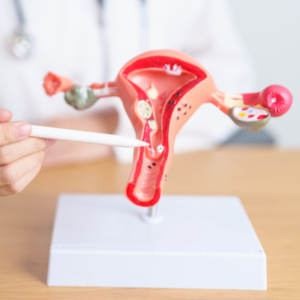 Uterine fibroid embolization (UFE) offers a promising, minimally invasive alternative option for women with fibroids and heavy bleeding. Uterine fibroids, or leiomyomas, are benign growths that develop in or around the uterus and can cause symptoms like heavy menstrual bleeding, pelvic pain, and pressure on surrounding organs. While they are non-cancerous, fibroids can severely affect a woman’s quality of life, especially when they cause excessive bleeding and anemia. UFE effectively treats fibroids by reducing blood flow to them, alleviating symptoms while preserving the uterus.
Uterine fibroid embolization (UFE) offers a promising, minimally invasive alternative option for women with fibroids and heavy bleeding. Uterine fibroids, or leiomyomas, are benign growths that develop in or around the uterus and can cause symptoms like heavy menstrual bleeding, pelvic pain, and pressure on surrounding organs. While they are non-cancerous, fibroids can severely affect a woman’s quality of life, especially when they cause excessive bleeding and anemia. UFE effectively treats fibroids by reducing blood flow to them, alleviating symptoms while preserving the uterus.
Understanding Uterine Fibroid Embolization
Uterine fibroid embolization, also known as uterine artery embolization (UAE), is a procedure performed by an interventional radiologist. Unlike surgical options like myomectomy (removal of fibroids) or hysterectomy (removal of the uterus), UFE does not involve cutting or direct removal of the fibroids. Instead, it works by blocking the blood supply that nourishes the fibroids, causing them to shrink over time.
During UFE, the radiologist inserts a thin catheter through a small incision, usually in the groin or wrist, and guides it to the uterine arteries that supply blood to the fibroids. Small particles, typically made of polyvinyl alcohol or other synthetic materials, are then released into the arteries, blocking the blood flow to the fibroids. Without blood, the fibroids begin to shrink, reducing symptoms gradually over the following weeks and months.
Benefits of Uterine Fibroid Embolization for Heavy Bleeding
One of the primary benefits of UFE is its ability to effectively reduce or eliminate heavy menstrual bleeding, which is one of the most common and troubling symptoms of fibroids. Women with fibroids often experience menorrhagia (heavy menstrual bleeding), which can lead to anemia, fatigue, and discomfort. Studies have shown that UFE can significantly decrease menstrual blood loss in over 90% of patients, offering lasting relief and reducing the need for other treatments like iron supplements or blood transfusions.
Additional benefits of UFE include:
- Minimally Invasive Approach: Unlike traditional surgeries, UFE does not require large incisions or removal of any tissue, meaning less pain and a quicker recovery time.
- Uterus Preservation: For women who wish to keep their uterus intact, UFE provides an effective alternative to hysterectomy. Although pregnancy after UFE is possible, women interested in future fertility should discuss this with their healthcare provider, as UFE may have variable effects on fertility.
- High Success Rate: UFE has a high success rate in reducing symptoms of fibroids, including heavy bleeding, pelvic pain, and pressure. Many patients report improved quality of life within a few months of the procedure.
- Outpatient Procedure: UFE is typically done on an outpatient basis, allowing most patients to go home the same day.
The Procedure and Recovery Process
The UFE procedure usually takes one to two hours. Patients are lightly sedated but awake, allowing them to recover faster than from a traditional surgery. Most women experience cramping, pain, and mild discomfort following the procedure, which can be managed with pain medication.
Recovery is generally quicker than for surgical options, with many women returning to normal activities within one to two weeks. However, the full effects of UFE on fibroid size and symptoms may take a few months to manifest as the fibroids shrink gradually. Women often notice a significant reduction in bleeding, less pressure on the bladder and intestines, and relief from pelvic pain.
Risks and Considerations
While UFE is a safe and effective procedure, it carries some risks and may not be suitable for everyone. Potential side effects include:
- Post-Embolization Syndrome: Some women experience flu-like symptoms, including low-grade fever, nausea, and pain, which usually subside within a few days.
- Infection: As with any procedure involving catheters, there’s a slight risk of infection, but this is rare.
- Possible Impact on Fertility: UFE is generally not recommended for women who prioritize future fertility, as it may impact the blood flow to the ovaries and endometrium. Alternative treatments like myomectomy may be suggested for women planning future pregnancies.
Who is a Good Candidate for UFE?
UFE is ideal for women who suffer from symptomatic fibroids, particularly heavy bleeding, and who want a minimally invasive treatment that preserves the uterus. It is also suited for those looking to avoid the long recovery associated with more invasive surgeries.
Our OB/GYNs Can Help
If you’re experiencing fibroid-related symptoms, call us today at 770.720.7733. Or, schedule an appointment online with one of our board-certified OB/GYNs to determine if it is the right treatment option for your unique needs and health goals.


